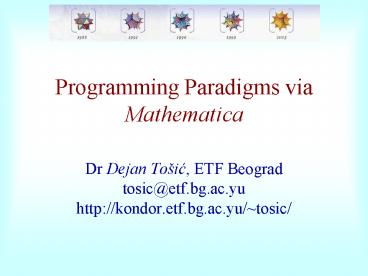Programming Paradigms via Mathematica - PowerPoint PPT Presentation
1 / 28
Title:
Programming Paradigms via Mathematica
Description:
Patterns. A pattern is an expression that is used to specify a set of expressions. ... For example, the pattern {_,_} matches any list with two elements. ... – PowerPoint PPT presentation
Number of Views:79
Avg rating:3.0/5.0
Title: Programming Paradigms via Mathematica
1
Programming Paradigms via Mathematica
- Dr Dejan Toic, ETF Beograd tosic_at_etf.bg.ac.yu
http//kondor.etf.bg.ac.yu/tosic/
2
Mathematica
- Mathematica is the world's only fully integrated
environment for technical computing. - The visionary concept of Mathematica was to
create once and for all a single system that
could handle all the various aspects of
technical computing in a coherent and unified
way. - The key intellectual advance that made this
possible was the invention of a new kind of
symbolic computer language that could for the
first time manipulate the very wide range of
objects involved in technical computing using
only a fairly small number of basic primitives.
3
Mathematica combines ideas from many different
sources
- LISP Mathematica can manipulate lists using the
data structures of the programming language LISP.
- PROLOG Mathematica uses pattern matching
capabilities taken from PROLOG to express
mathematical rules in a simple way. - APL Mathematica's simple manipulation of
structured data has been pioneered by APL. - SIMULA, SMALLTALK, and C Object-oriented
elements make code development easier. - PASCAL, FORTRAN, and C Traditional procedural
programming style. - Other Features Modularization and Built-In
Functions.
4
Software development cycle
5
Square brackets , Curly braces , and
Parentheses ( )
- Parentheses ( ) are used in Mathematica for
grouping in arithmetic. - Square brackets are used for enclosing the
arguments of functions. - Curly braces are used for entering lists.
- Using square brackets to enclose function
arguments avoids the ambiguity in traditional
mathematical notation between parentheses that
enclose function arguments and parentheses that
are used for grouping arithmetic operations.
6
Normal Expression
- A normal expression is an expression that has a
head and elements (arguments). - The head of the normal expression fa,b, for
example, is f, and the elements are a and b. - The head and the elements in a normal expression
are also expressions, and can, for example, be
other normal expressions.
7
Atoms
- Expressions that are not normal expressions are
called atoms. - Atoms are either
- symbols,
- numbers, or
- strings.
- All expressions are constructed from atoms.
8
Patterns
- A pattern is an expression that is used to
specify a set of expressions. - Any expression in the set of expressions
specified by a pattern is said to match the
pattern. - The simplest non-trivial pattern is Blank,
which matches any expression. Blank is usually
entered as a single underscore character _. - For example, the pattern _,_ matches any list
with two elements.
9
Canonical example
10
Built-in Functions
One way to program a function that computes the
factorial of a non-negative integer is to simply
use the built-in function Factorial.
11
Composition of Functions Anonymous (pure)
function
12
Procedural FORTRANesque programming Do
13
Straight-forward implementation Product
14
Functional programming
15
Range generates a list of consecutive integers
16
Times multiplies together its arguments
17
Rule-based programming
18
Transformation rules
- Rules are a mechanism for replacing a variable
with a value in an expression. - A rule can transform one expression, lhs, into
another expression, rhs lhs -gt rhs
19
Rule-based programming style
- The transformations are described by rules which
separate the description of the sub-object to be
replaced (the pattern) from the calculation of
the replacement. - Optionally, rules can have further conditions
that restrict their applicability. - The transformations are controlled by explicit or
implicit strategies.
20
Mixed programming Definitions, Rules, Patterns
21
Dynamically Stored Results
22
Information on objects ? command
23
Recursive programming
24
C-style programming For
25
Iterative programming While
26
Traditional form Product
27
Definition using pure function
28
Benefits
- Visionary concept of advanced computing
- Fully integrated mathematical environment
- Symbolic computer language
- Various programming paradigms
- Short software development cycle































